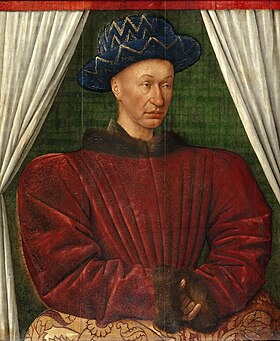
"The king is dead, long live the king!" is a traditional proclamation made following the accession of a new monarch in various countries. The seemingly contradictory phrase simultaneously announces the death of the previous monarch and asserts continuity by saluting the new monarch.
This phrase has become a popular phrasal template. Given the memorable nature of the phrase (owing, in part, to epanadiplosis), as well as its historic significance, the phrase crops up regularly as a headline for articles, editorials, or advertisements on themes of succession or replacement. Robert Cecil, one of the architects of the League of Nations, concluded his speech at the final session of the League of Nations with the statement: "The League is dead. Long live the United Nations."
Origin
| This section does not cite any sources. Please help improve this section by adding citations to reliable sources. Unsourced material may be challenged and removed. (September 2022) (Learn how and when to remove this message) |
The original phrase was translated from French (Le roi est mort, vive le roi !), which was first declared upon the accession to the French throne of Charles VII after the death of his father Charles VI in 1422. In France, the declaration was traditionally made by the Duke of Uzès, a senior peer of France, as soon as the coffin containing the remains of the previous king descended into the vault of the Basilica of Saint-Denis in northern Paris. The phrase arose from the law of le mort saisit le vif—that the transfer of sovereignty occurs instantaneously upon the moment of death of the previous monarch. "The King is dead" is the announcement of a monarch who has just died. "Long live The King!" refers to the heir who immediately succeeds to a throne upon the death of the preceding monarch.
At the time French was the primary language of the nobility in England, and the proclamation was quickly taken up as ideally representing the same tradition—which in England dates back to 1272, when Henry III died while his son, Edward I, was fighting in the Crusades. To avoid any chance of a war of succession erupting over the order of succession, the Royal Council proclaimed: "The throne shall never be empty; the country shall never be without a monarch." Thus, Edward was declared king immediately, and he reigned in absentia until news of his father's death reached him and he returned to England.
Usage
In some monarchies, such as the United Kingdom, an interregnum is usually avoided by using the idea of immediate transfer of power behind the phrase (i.e., the heir to the throne becomes the new monarch immediately on their predecessor's death). This famous phrase signifies the continuity of sovereignty, attached to a personal form of power named Auctoritas. This is not so in some other monarchies where the new monarch's reign begins only with coronation or some other formal or traditional event. In the Polish–Lithuanian Commonwealth for instance, kings were elected, which often led to relatively long interregna. During that time the Polish primate served as an interrex (ruler between kings). Ernst Kantorowicz's famous theory of the king's two bodies (1957) showed how auctoritas (Kantorowicz used the synonym term—here—of dignitas) was transferred from the defunct sovereign to the new one.
In the Kingdom of Thailand, to conclude the national televised address on 13 October 2016, regarding the death of King Bhumibol Adulyadej, the Prime Minister proclaimed "His Majesty King Bhumibol Adulyadej, Rama IX, is dead. Long live His Majesty the new King." However, the royal succession in Thailand is not automatic, and Vajiralongkorn continued to function as the Crown Prince until his formal accession and proclamation ceremony on 1 December 2016.
In monarchies which permit female succession to the throne, "king" can be replaced by "queen" where appropriate.
See also
Notes
- The exact punctuation used when written varies from source to source, with the comma on occasion being replaced by a full stop, a semicolon, a colon, or a dash.
References
- Ryken, Philip Graham (2011). King Solomon: The Temptations of Money, Sex, and Power. Crossway. p. 18. ISBN 978-1-4335-2154-6.
- Readman, Kylie (2021). "The lecture is dead, long live the lecture: Redefining higher education in a digital age". timeshighereducation.com. Times Higher Education.
"The CV is Dead. Long Live the CV!". hinterview.com.
"Python is dead. Long live Python!". sophos.com. 3 January 2020.
"Paper is dead; long live paper". ycombinator.com.
"The resume is dead – long live the resume". thenextweb.com. 6 April 2016. - Scott, George (1973). The Rise and Fall of the League of Nations. Hutchinson & Co Ltd. ISBN 978-0-09-117040-0.
- Monarch Butterfly NZ Trust (18 March 2013). "The Monarch is dead, long live the Monarch". Scoop.co.nz News. Retrieved 21 October 2024.
- Statement by Prime Minister General Prayut Chan-o-cha after the announcement of Royal Household Bureau. Royal Thai Government.